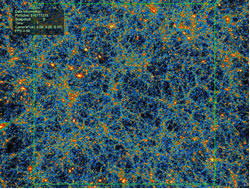Two leading scholars have been invited to deliver public lectures on Cosmology and Astrophysics organized by the Research Grants Council with the Hong Kong Science Museum on 7 July 2012 (Saturday). Details of the lectures are as follows:
| Topic | Speaker | Time |
|---|---|---|
| New Developments in Cosmology | Professor Chu Ming-chung (Professor, Department of Physics, The Chinese University of Hong Kong) | 2:30 pm - 3:30 pm |
| Microwave Observations of the Moon | Professor Chan Kwing-lam (Professor, Department of Mathematics; Director, Center for Space Science Research, The Hong Kong University of Science and Technology) | 3:30 pm - 4:30 pm |
Venue: Lecture Hall, Hong Kong Science
Museum (Location
Map)
Language: Cantonese
Free admission on a first-come, first-served
basis.
For enquires, please contact us at 2524
3987 or rgc@ugc.edu.hk.
First Session
Topic: New Developments in Cosmology
Speakers: Professor Chu Ming-chung
Time: 7 July 2012 (Saturday) 2:30pm - 3:30pm
Brief introduction:
In recent years, advances in cosmological observation have led to large volume of precision data. As a result, physicists have gained tremendous insight into the content and evolution of the universe. For example, the precision measurement of cosmic microwave background – remnant radiations from the Big Bang – brings to the scientific community wealth of information about the condition of the universe 13.7 billion years ago. The confirmation that the universe is full of invisible matter and energy – dark matter and dark energy, tells us that normal matter that we are familiar with contributes a negligible fraction to the total mass-energy of the universe! These breakthroughs have brought surprises and stimulated new theories and research. In this talk, I will give a survey of the new developments in cosmology and highlight some of the outstanding mysteries. |
 |
Second Session
Topic: Microwave Observations of the Moon
Speaker: Professor Chan Kwing-lam
Time: 7 July 2012 (Saturday) 3:30pm - 4:30pm
Brief introduction:
Ground-based microwave observations of the moon had been made even before the space age, but the spatial resolutions were generally poor. China’s Chang’E-1 (CE-1) was the first spacecraft that carried a microwave radiometer (MRM) to study the moon in circumlunar orbit. Microwaves originate from layers below the surface and contain information about the physical properties of the lunar regolith (the loose surface layer formed by meteoric bombardment). Lunar surface samples from the Apollo era have shown that the regolith contains a notable amount of helium-3, a potentially ideal reactant for producing fusion energy. One of the objectives of the MRM on CE-1 was to determine the thickness of the regolith so that the amount of helium-3 within can be estimated. The MRM data of CE-1 were made available for scientific analysis in early 2010, and a number of groups including one at the Hong Kong University of Science and Technology (HKUST) have been working on this task since that time. In collaboration with the National Astronomical Observatories (Chinese Academy of Sciences), the HKUST group developed a procedure so that maps corresponding to noontime and midnight can be constructed. Relevant research has been presented in various countries and regions. In this talk, the findings and interpretations of the presently available results will be discussed. |
 |